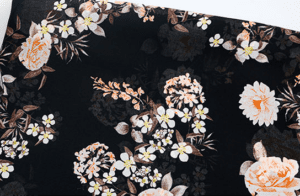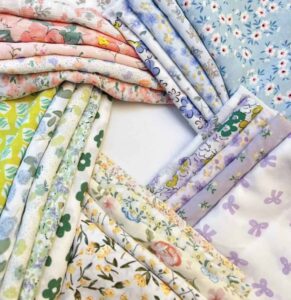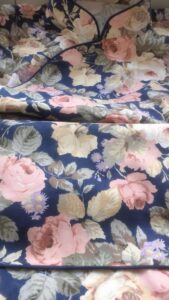Ring-spun yarns in the hinterland
The most versatile spinning method in the market today, where the fibre strips are drawn through the ring spindle and introduced by spinning the tube faster than the ring, and the cotton yarn is felted into fine yarn. It is widely used in the spinning of various short fibres. The yarn has a compact structure and high strength and is suitable for thread making as well as for various products such as weaving and knitting.
Ring spinning (combing) process: clearing room – carding – pre-joining – strip and reel – combing – headjoining – secondjoining – roving – spinning – winding
Ring spinning (combing) process: clearing room – carding – first parallel – second parallel – roving – spinning – winding
Spun yarn without flick
A spinning method in which the fibres in the fibre strips are bonded to each other to form a yarn using an adhesive. After the roving has been drawn by the drafting unit, the strips are conveyed to the twisting drum, where they come into contact with a thin layer of binder from the trough box. The fibre strips are carried forward by several small rotary rollers with the drum, one of which also moves axially in a reciprocating motion, rolling the fibre strips into a circular cross-section and bringing each fibre into uniform contact with the binder. The circular fibres are dried by means of a heater and the fibres are bonded to each other to form the yarn. The spinning speed is two to four times greater than conventional spinning methods and the yarn is ready for weaving.
Self-spinning yarn in the hinterland
A non-traditional spinning method. Two fibre strips are drawn through the drafting device and output by the front roller and the twisting roller, which are combined at the yarn guide hook. The twisting rollers, in addition to turning, also move rapidly in a reciprocating axial direction to twist the yarn strips, so that the yarn strips before and after the twisting rollers obtain a twist back in the opposite direction. The morphology of the self-flicking yarn is characterised by alternating twist-backs in the opposite direction of the adjacent yarn sections, with no twist-back at the alternating point.
This spinning method is used exclusively on multi-ply yarns, e.g. for woollen or wool-like chemical fibre products. High quality self-twisting yarns can be used directly for weft knitting, but for warp yarns for weaving, twisted self-twisting yarns must be used to improve the strength properties.
Centrifugal spinning in the hinterland
Continuous spinning method with high speed centrifugal jar (cup) and lifting guide tube for twisting and winding. The roving is continuously output by the front roller after the drafting device, and enters the cylindrical centrifugal jar at high speed via the yarn guide hook and the yarn guide tube.
The yarn guide tube is lifted according to a certain rule, forming a cross-winding yarn cake, when the winding reaches a certain length, the front roller stops outputting fibre strips, the yarn guide tube rises and exits the centrifugal jar, the empty cylinder tube descends sharply into the centrifugal jar, the yarn head hooks the yarn hook on the lower part of the cylinder tube, so that the yarn on the yarn cake is rewound onto the cylinder tube, the rewinding is completed and the full tube is taken down. Compared with ring spinning, power consumption, back to the wire, broken head difficult to deal with, yarn rewinding to the tube, the front roller needs to stop, affecting productivity, now few people use.
Spinning with cap spindles
A spinning method in which the actual yarn is twisted and wound by means of a spindle cap and a tube. Used in woollen and linen spinning. The bell-type spindle cap is fixed to the top of the spindle and the barrel tube is live-set on the spindle. The rough yarn is drawn by the drafting device and then the front roller outputs a continuous fibre strip, which is wound on the barrel tube by the guide hook and the lower edge of the spindle cap. When the tube rotates, it drives the yarn strip around the lower edge of the spindle cap and the yarn strip is continuously twisted back together. The frictional resistance of the spindle cap to the rotating yarn strip keeps the yarn strip wound on the tube. The tube is lifted and lowered in accordance with the lifting plate, and the yarn is wound into a certain form. The spinning tension of the cap spinning method is low and there are few broken ends.
Spinning with spindles
A spinning method in which the three actions of yarn drafting, twisting and winding are performed cyclically.
A working cycle is divided into four stages.
Stage 1: Spinning out. The drafting unit draws the roving and sends out the fibre strips, the spindle carriage leaves the drafting unit and moves outwards, slightly drafting the yarn strips, and the spindle rotates to twist the fine yarn.
Stage 2: Twisting. The drafting device and the spindle carriage are stopped and the spindle is continuously rotated to complete the twisting of the yarn.
Stage 3: Unwinding. The drafting device and the spindle carriage remain stationary, the spindle slowly rotates in the opposite direction of the twisting, rewinding the yarn loop from the tip of the spindle, the upper forming hook drops to guide the rewound loop and the lower forming hook rises to tighten the yarn strip.
Stage 4: winding. The drafting device continues to stop, the walking spindle carriage moves quickly towards the drafting device, the spindle rotates in the same direction as during twisting and coils the spun yarn, the upper forming hook guides the spun yarn so that it is wound tightly and forms a certain volume, the lower forming hook pulls the yarn strip tightly, which has been replaced by ring spinning etc.
Free end spinning in the hinterland
A new spinning method that loosens the fibre strips into single fibres and coalesces the single fibres into free end fibre strips, which are then twisted into yarn. The cohesive fibre strips rotate together with the yarn when twisting, in the form of free ends, because the fed fibre strips and free end fibre strips are broken, so also called “broken spinning”. There are different methods of coalescing single fibres into free-end fibre strips, such as airflow spinning or rotor spinning, electrostatic spinning, vortex spinning and dust cage (friction) spinning, among which airflow spinning is the most common application. At present, most of the free end spinning refers to air-flow spinning.
Compared with conventional ring spinning has the following advantages: twisting and winding movement separate, the total draft on the air spinning machine is much larger than the ring spinning machine, twisting can be carried out at high speed; twisting after the yarn directly wound into the tube, rolled capacity, the process is simplified; reduce the labour intensity of workers and improve the working environment.
Air-flow spun yarns in the hinterland
Also known as “rotating cup spinning”, one of the effective free end spinning methods, the core is a spinning cup, the fiber strip from the feed roller and the board between the input, by the high-speed small snapping roller (combing roller) open loose into a single fiber. The negative air pressure in the spinning cup causes the single fibres to enter the spinning cup with the complementary air flow through the conveying pipe, and under the centrifugal force of the high speed rotation of the cup, they are pressed along the smooth inner wall to the cohesive groove at the maximum inner diameter of the rotating cup, forming a ring of fibre strips with a raw head and a joint when the yarn tail is drawn in with the complementary air flow from the leading tube, also due to the centrifugal action of the rotating cup in the cohesive groove, so that the yarn tail is connected to the fibre strips. When the leading yarn is pulled out of the spinning cup, the fibre strip leaves the coalescing trough with the yarn tail and is simultaneously twisted into yarn by the high rotary rotation of the spinning cup, which is pulled out by the output roller through the twist stopper and the leading yarn tube, which is driven by the trough tube and wound into a tube.
Air-flow spinning process: clearing room – carding – first parallel – second parallel – air-flow spinning
Static spun yarns in the hinterland
One of the free end spinning methods. It consists of processes such as fibre opening, conveying, electrostatic coalescence, free end twisting and cylinder winding. Of these, two methods of fibre opening and conveying are used.
(1) The roller drafting is used as the opening mechanism and the fibres are transported using electrostatic field action.
(2) The felting roller is used as the opening mechanism and the cotton fibres are transported by airflow.
Electrostatic spinning yarn is suitable for weaving quilt cloth, furniture cloth, knitting jacquard tablecloth and curtain cloth, etc.; spinning a variety of blended yarn, bamboo yarn and core yarn, can also be made with cloth unique style of fabric.
Vortex Spinning
One of the free end spinning methods. The fibres are fed between the feed rollers and the feed plate and are loosened into fibres by small high speed rollers, which then enter the stationary vortex twist tube tangentially with the air flow through the conveying pipe. The lower part of the vortex twister is connected to a negative air pressure source and the nozzle is configured tangentially to the inner wall of the twister. The upward moving vortex of the nozzle is weakened by the negative air pressure source in the lower part of the tube, so that the fibres entering tangentially into the twisting tube are spiralled along the wall of the tube and coalesce in a stable vortex field to form a rotary fibre ring, which is connected to the fibre ring by centrifugal force when the yarn is joined, following the complementary airflow through the tube.
The mechanism and operation are simple, the spinning speed is very high, no fibre loss and less flying flowers, the twisting efficiency is low. It is suitable for the spinning of coarse and medium-sized yarns of pure or blended chemical fibres and is more effective for pile and core yarns.
Air-jet spinning in the hinterland
A non-traditional spinning method. It uses a jet stream to wrap some of the head-end free fibres around the periphery of the fibre strip when the strip is falsely twisted after drafting. Single and double nozzle types are available, the latter with good and consistent spinning quality. The fibre strips are drawn fine by the drafting device, output from the front roller, through the first nozzle, the second nozzle, the yarn guide hook and the yarn guide rosette, and are wound into a tube by the groove barrel. The vortex of the two nozzles rotates in opposite directions and the vortex of the second nozzle is stronger than the first nozzle, so that the twist back on the yarn strip between the two nozzles can overcome the torque and resistance added to the yarn strip by the first nozzle and pass to the jaws of the front roller. The free ends of the twisted fibres at the periphery of the fibre strip are affected by the first nozzle and wrap around the fibre strip in the opposite direction. The twisted fibres of the core pass through the nozzle and are retired, while the entangled fibres are wrapped tighter and tighter in the reverse retired process.
Compared with ring spinning, it has the advantages of high output, large rolls and short processes. It is suitable for spinning all kinds of staple and filament corespun yarns and processing of combined medium and long chemical fibre yarns. Murata is a specialist in air-jet spinning with its MJS, MVS and RJS yarns, which are similar to air-flow spinning and have a hard feel and good hairiness.
Air-jet spinning process: clearing room – carding – pre-joining – strip and reel – combing – first runner – second runner – air-jet spinning
Friction spinning in the hinterland
A method of yarn formation using the frictional effect of the machine surface on the surface of the yarn strip to produce twist. The more established ones are dust cage spinning.
Dust cage spinning
Also known as (Dreif spinning) friction spinning of a kind, mostly together called friction spinning, is a free end spinning method. The principle is that the fiber strip by the roller loosening into a single fiber, through the role of airflow, blowing to a rotary dust cage surface, a pair of dust cage between the spacing is very little, rotary speed and turn the same, with the dust cage rotary fiber layer reached the two dust cage triangle, by the two dust cage surface rubbing twist into yarn, by the guide yarn hook guide yarn rola, by the winding mechanism directly wound into the tube. Suitable for spinning coarse special yarns, can also clip filament spinning core yarn, usually woven thick fabrics or a variety of blankets.
























